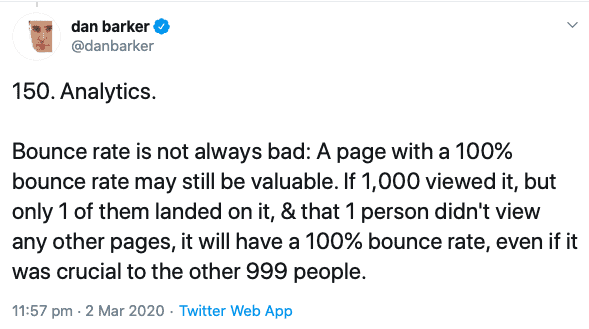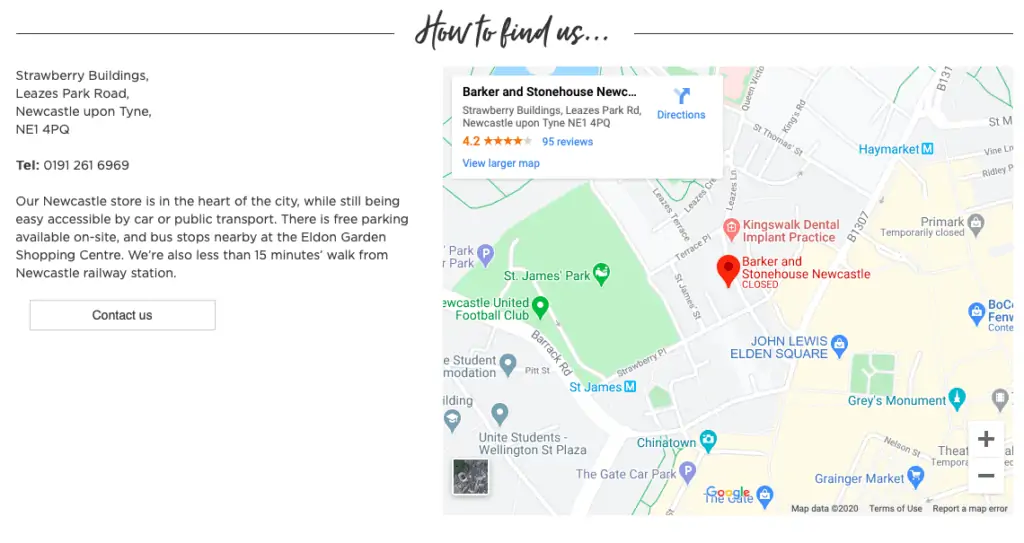Bounce rate is a metric that is often talked about, but how useful is it for ecommerce sites?
With the help of a Dan Barker Twitter thread, we’ll look at what bounce rate tells us, and how it can be used.
What is bounce rate?
According to Google, a ‘bounce’ is a single session on your site. It’s a session that triggers just one request to the Analytics server. For example, when a user views a single page but leaves ‘without triggering any other requests to the Analytics server during that session’.
Bounce rate is a measure of the percentage of visits to your site where only a single page was viewed.
That’s all it tells us, so it’s important to be aware of what that actually means. For example, a user might spend 15 minutes reading a page before leaving. That would be a bounce, but would that mean the page was unsuccessful?
Are high bounce rates a cause for concern?
People do worry about high bounce rates, but it’s not necessarily a bad thing.

Some people have a naturally high bounce rate, but that doesn’t mean they aren’t fulfilling their purpose. For example, a contact us page, or a page showing local store details may always have a high bounce rate.
This is because a lot of people will search Google for store and location or contact number. When they land on the page and find what they need, they may leave without viewing any other pages on the site.
Over time, this behaviour will lead to higher bounce rates but it doesn’t mean that this page is unsuccessful. If customers are finding contact details or visiting the local store, then the page has done its job.

So high bounce rates aren’t necessarily bad, but equally, low bounce rates aren;t always a good indicator.
For example, super low bounce rates (those in single figures for example) are often a sign that your analytics setup is broken. It could be a sign that pages are tracking two pageviews for each one or that ‘events’ on the page such as a video play is being counted as a view.
Bounce rates aren’t such a meaningful metric for ecommerce sites in general, certainly not at the overall site level. There are too many elements and variables to infer too much from stats like site-wide bounce rate.
It can be more useful for publishers, as bounce rate can be a measure of how useful and engaging the content is, and how successful publishers are at cross-promoting content. As with ecommerce though, it shouldn’t be relied upon too much.
In one example, recounted by Dan Barker here, he was asked to look at a site with lots of editorial content as the owner was concerned by the relatively high bounce rate.
However, the high bounce rate wasn’t necessarily a bad thing. The site sent out a daily email with an article link in it – many people were clicking through to the article, reading it, then leaving.
The homepage also had a high bounce rate, but this was due to people checking back several times a day for new content and leaving when they didn’t find any. In other words, the popularity of the site was causing the high bounce rate to some extent.
This was fixed in three ways:
- Put more articles on the homepage for visitors to find.
- Promote related content next to articles to give readers other options to click on.
- Create more content to satisfy user demand.

When bounce rate can be useful
For ecommerce sites, reducing bounce rate can be done by following some of the same principles, such as cross promoting related or interesting products, or ensuring that key calls to action are visible. They can also address issues such as site speed.
These steps will help to keep shoppers moving through the site and reduce bounce rates, but these are also things that are also solved by keeping an eye on other metrics.
There are examples where bounce rates can be useful though. For example, sites can compare like for like pages for performance across different channels for bounce rates.
If one product has high bucbe rates from Google Shopping traffic, then it can be removed from the feed. If certain product subcategory pages have high bounce rates, then this is a cue to investigate factors such as stock levels.
In summary
Bounce rate is one of those metrics that gets a lot of attention, but it’s simply too generalised and vague to be very useful for ecommerce sites.
As a measure of a site’s stickiness it can be a useful measure, but it’s probably more useful to publishers than online retailers.
For ecommerce sites, apt from the uses mentioned here, there are simply many more useful metrics to look at other than bounce rates.
